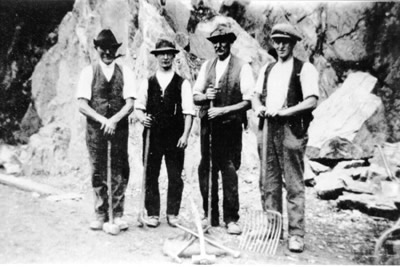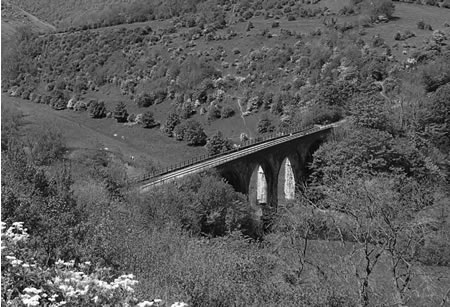|
After the difficulties experienced with Nuthalls,
(who were now in receivership), the contractors for the L&B, Robert McAlpine
& Co was chosen for the new railway with Rhys Davies BSc C.Eng. as
consulting engineer. Davies was a subordinate to James Szlumper, having
assisted him in laying out the L&B and Vale of Rheidol Railways, and was
recommended as Chief Engineer for the project by Szlumper, who was
unavailable due to his commitments in Wales.
Construction of the 40 miles of main-line and branches took nearly three
years. The works included 76 bridges, seven viaducts (Robert Barnard C.Eng
consulting engineer) and four tunnels on the main line alone.

gradient profile - click on image to enlarge
VIADUCTS
Glenlyn / Lynton 310 yards
Watersmeet 290 yards
East Lyn 185 yards
Badgeworthy, 74 yards
Nutscale 190 yards
Stoke Pero 180 yards
Cloutsham 152 yards
TUNNELS
Watersmeet 164 yards
Ashton Cleeve 109 yards
County Gate / Glenthorne Hotel 339 yards
Porlock / Lucott Moor 2745 yards (1.55 miles)
Faced with such daunting prospects, and recognising that the heaviest works
were concentrated in the summit section, it was decided to open the line in
stages, thus spreading the burden of construction.

Porlock tunnel under construction (photo: Institution of Civil Engineers)
The eastern section, Minehead to Wootton
Courtenay, and the branch thence to West Porlock, were opened to traffic in
1901. The railway was thus in a prudent position of being able to earn
revenue while continuing construction of the heavier engineering works. Services over this section
were operated by the two handsome 4-6-4 tanks delivered to Minehead by the
North British Locomotive company. These locomotives were considerably more
powerful than the existing Manning Wardles. Named ‘Axe’ and 'Lyd', after local
rivers, these engines were to have been supplemented by further machines of similar design, but sadly, they were
never built. Additional coal wagons and coaches were purchased for the branch
lines a year later.

The end of the line is actually on the Minehead harbour
breakwater
Station buildings were built in Nuremburg style
(similar to the L&B) except at Minehead where 'GWR
style architecture’ to harmonise with the adjacent standard-gauge station was
insisted upon.

the new narrow gauge station at Minehead was
in the same style as the GWR which can be seen in the background
The western section, Woody Bay to County Gate,
opened in 1902. The harbour branch was completed in the same year, and was
one of the most expensive railway projects per mile of the time. The harbour was ready for
the first shipment of coal to arrive the following month. By this time, the
Lynton and Barnstaple railway had been forced to accept that the extension
was a reality and an arrangement was made to operate this section until the
extension was completed.

navvies pose during the railway construction
Finally, the summit section was readied for traffic, and amid much
celebration, the first through train steamed triumphantly into Minehead on April 6th 1903
to be met by Minehead town dignitaries,
three years to the day of the Minehead Extension Railway Act’s passing. The
ten coach train was double headed with 'Axe' and 'Lyd' and was filled to
capacity.

The Minehead town band greeted the first
train as part of the celebrations
It quickly became apparent that savings could be
made if the entire main line was operated as one railway. An uneasy truce was
made between Newnes and Halliday via an intermediary. The Glenthorne Estate
proposed that the extended railway should be renamed the Minehead and
Barnstaple Railway and a suitable device was struck.

click image to enlarge
In reality, the new name was popular in Somerset but Devon folks stubbornly
continued to call the line the Lynton and Barnstaple! Lynton Junction (Barbrook)
was regarded as the 'frontier' in much the same manner as Beddgelert was
later to become on the Welsh Highland Railway. This was exacerbated by the
continuing friction between Newnes and the Hallidays.
At the same time,
agreements were finally made with the Lynton and Barnstaple railway which
became the titular operator of the line in exchange for a percentage of
operating profits.

Nutscale viaduct

|